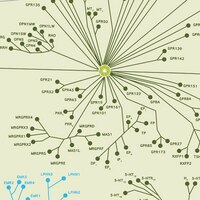The vasopressin V1b receptor critically regulates hypothalamic-pituitary-adrenal axis activity under both stress and resting conditions.
Tanoue, Akito, et al.
J. Clin. Invest., 113: 302-9 (2004)
2004
Zobrazit abstrakt
The neurohypophyseal peptide [Arg(8)]-vasopressin (AVP) exerts major physiological actions through three distinct receptor isoforms designated V1a, V1b, and V2. Among these three subtypes, the vasopressin V1b receptor is specifically expressed in pituitary corticotrophs and mediates the stimulatory effect of vasopressin on ACTH release. To investigate the functional roles of V1b receptor subtypes in vivo, gene targeting was used to create a mouse model lacking the V1b receptor gene (V1bR-/-). Under resting conditions, circulating concentrations of ACTH and corticosterone were lower in V1bR-/- mice compared with WT mice (V1bR+/+). The normal increase in circulating ACTH levels in response to exogenous administration of AVP was impaired in V1bR-/- mice, while corticotropin-releasing hormone-stimulated ACTH release in the V1bR-/- mice was not significantly different from that in the V1bR+/+ mice. AVP-induced ACTH release from primary cultured pituitary cells in V1bR-/- mice was also blunted. Furthermore, the increase in ACTH after a forced swim stress was significantly suppressed in V1bR-/- mice. Our results clearly demonstrate that the V1b receptor plays a crucial role in regulating hypothalamic-pituitary-adrenal axis activity. It does this by maintaining ACTH and corticosterone levels, not only under stress but also under basal conditions. | 14722621
 |
Vasopressin receptors.
Birnbaumer, M
Trends Endocrinol. Metab., 11: 406-10 (2000)
1999
Zobrazit abstrakt
The biological effects of arginine vasopressin (AVP) are mediated by three receptor subtypes: the V1a and V1b receptors that activate phospholipases via Gq/11, and the V2 receptor that activates adenylyl cyclase by interacting with Gs. Isolation of the cDNAs encoding the V1a and V1b receptor subtypes explained the tissue variability of V1 antagonist binding, whereas identification of the cDNA and gene encoding the V2 receptor provided the information to identify the mutations responsible for X-linked nephrogenic diabetes insipidus. Mutations that abrogate the production and/or release of AVP from the pituitary have diabetes insipidus as their most dramatic manifestation, indicating that the maintenance of water homeostasis is the most important physiological role of this neuropeptide. Evidence for a significant role of AVP in blood pressure control, although actively sought, has been scant. | 11091117
 |












